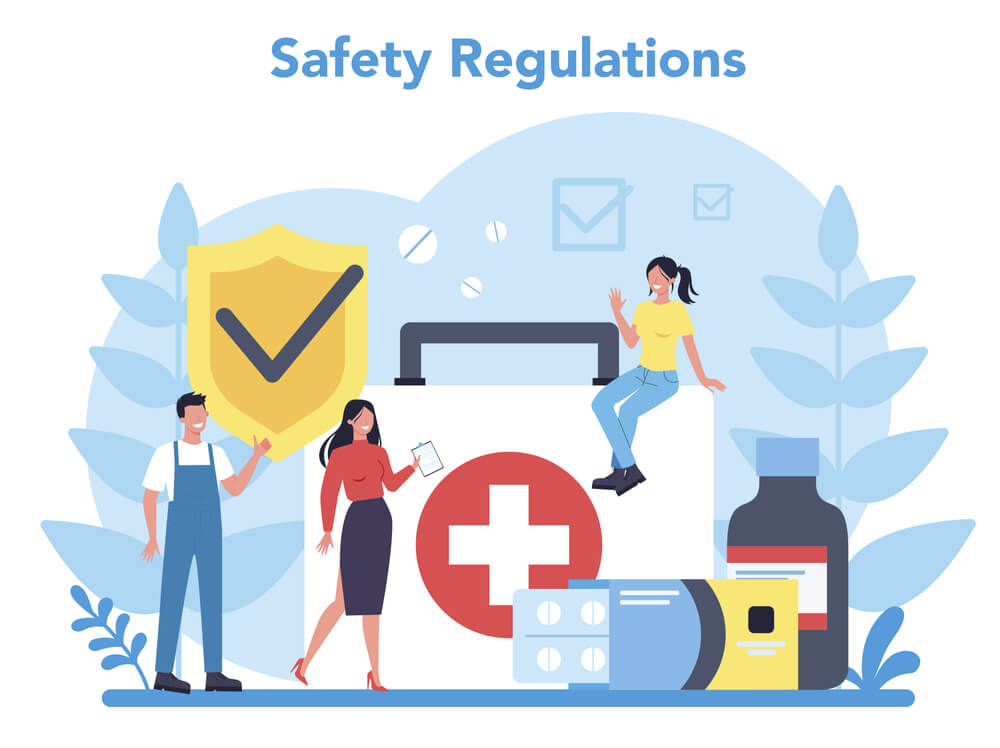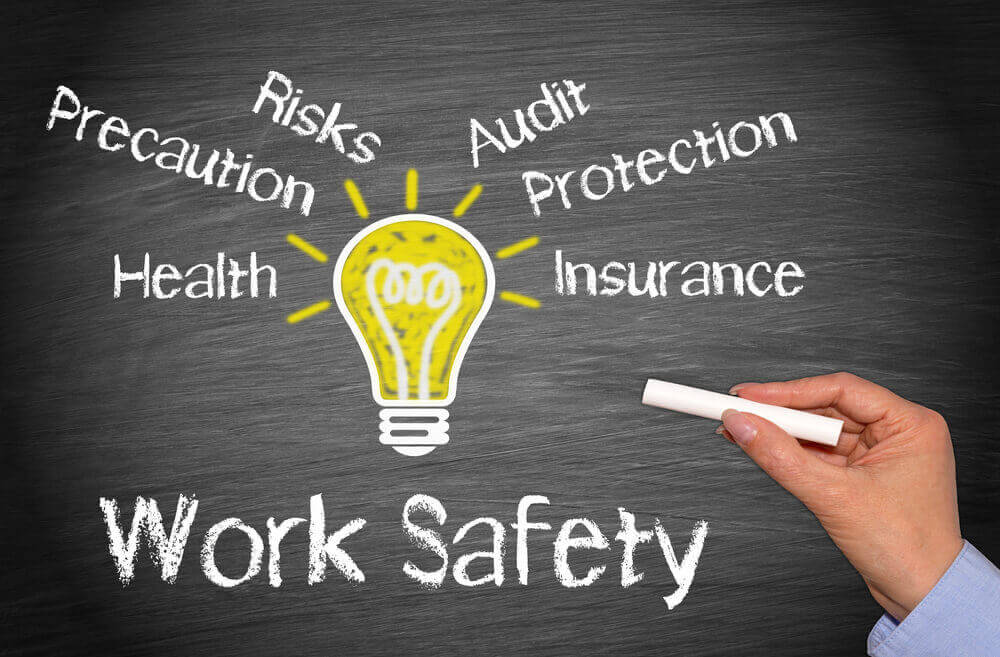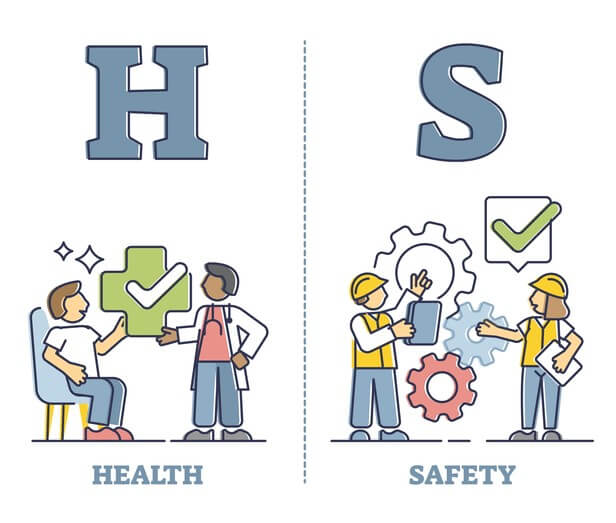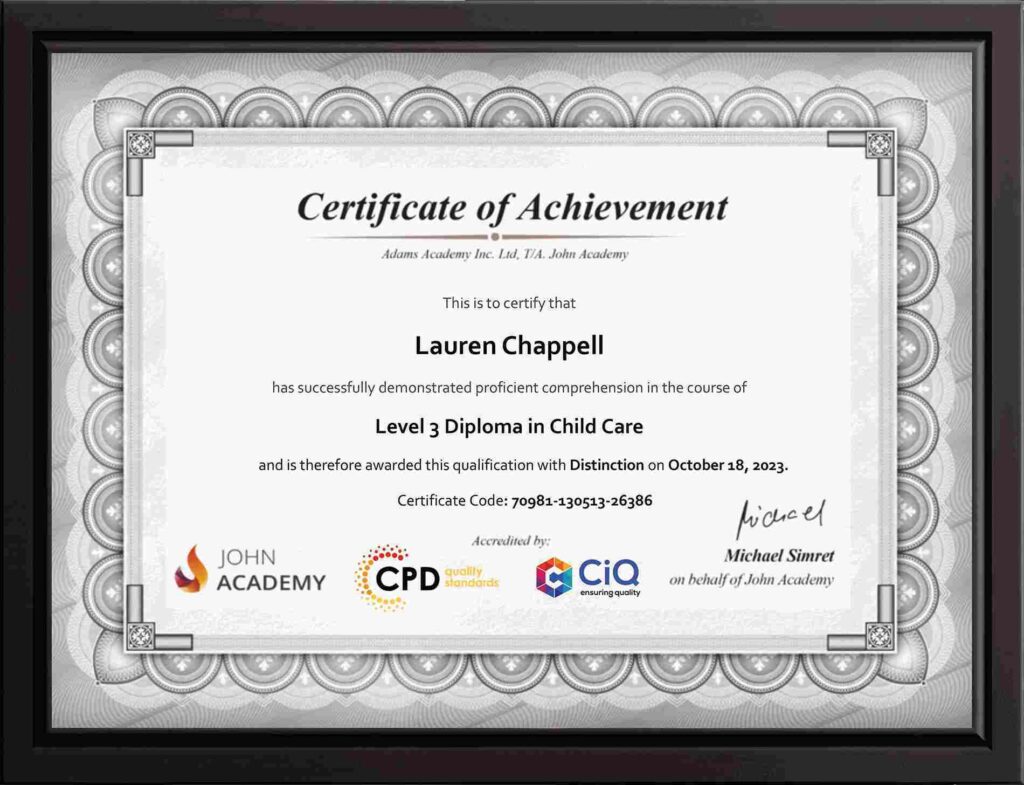

In this blog, we are going to look into the different responsibilities of a health and safety manager.
Table of Contents
What is Health and Safety Management?
Since we are talking about the health and safety manager’s responsibilities, first, we need to know what Health and Safety Management is.
The term defines a systematic way of identifying, assessing, and managing risks in any workplace. The goal is to develop and apply safety procedures and policies for that particular company. The policies and procedures are aimed at ensuring the well-being and safety of the employees of that organisation, as well as the guests.
Putting this management into practice reduces the risk of workplace injuries. Not only that, but it also ensures compliance with legal and regulatory requirements.
What are the Legal Reasons for Health and Safety Management?
The core justification for health and safety management is legal compliance. It imposes stringent duties on employers and workers to protect workers’ health and safety at work.
To protect staff, laws such as the Management of Health and Safety at Work Regulations 1999 involve detailed risk assessments and the implementation of suitable controls. There are harsh penalties for breaking these regulations, such as fines, jail time, and damage to the company’s reputation.

And legal frameworks oversee the rights and responsibilities of everyone involved. Also, they set the boundaries that regulate how businesses act.
Besides being legally needed, maintaining these laws is morally important to protect human rights and ensure responsibility. When legal duty breaches, penalties act as preventative measures that decrease the risk. Penalties can be in the form of issuing improvement or restriction notices. Meanwhile, criminal prosecutions and civil lawsuits provide retributive and financial compensation.
Following health and safety rules is essential to ethical business practices. Because, in the end, companies are liable for protecting the health and safety of their staff, clients, and other stakeholders.
Suggested reading — What are the Main Health and Safety Regulations in the UK?
What Could Happen if Health and Safety are not Managed Correctly?
Ignoring health and safety in the workplace can have fatal consequences, such as legal actions and financial losses. However, the most prominent impact will be work-related injuries. It is not just the injury itself that is the negative outcome, but what comes as a result of that injury. For the employee, the injury could lead to disability or, in the worst case, death. In either case, his or her family will need to bear the cost of that damage.
However, at some point, employers, business owners, governments, and society in general may face larger consequences due to this physical or mental damage.
What is a Health and Safety Manager?
We informed you earlier about Health and Safety management. Now, let us find out who the Health and Safety manager is. It is the title of the person in charge of designing the organisation’s health and safety policy. Also, they ensure the policy is followed correctly and monitor employee compliance.

What is the Purpose of a Health and Safety Manager?
The main purpose of a Health and Safety Manager is to prevent and reduce workplace injuries. This task consists of designing safety plans and implementing them in the workplace. On top of that, he or she also needs to conduct risk assessments and training sessions & workshops. This will help them familiarise the employees with safety plans and regulations.
Health and Safety Manager responsibilities and their purpose are closely aligned.
Health and Safety Manager Responsibilities
A Health and Safety Manager responsibilities fall into different categories. Notable Health and Safety Manager responsibilities are:-
-
Policy and Strategy Development:
-
- Establishing business strategy-aligned management structures and policies for occupational health and safety.
- Establishing and implementing policies to foster a culture that prioritises health and safety
-
Risk Assessment and Management:
-
- Planning and implementing an elaborate health and safety management system under the relevant laws and best practices.
- Regularly carrying out comprehensive risk assessments, hazard identification, and incident investigations.
- Assessing practices, procedures, and infrastructure. This will help adhere to rules and effectively reduce hazards.

- Compliance and Reporting:
-
- Making sure that health and safety laws and regulations are followed.
-
- Keeping records of, disclosing, and comparing work health and safety data to industry standards.
-
- Encouraging the appropriate reporting of incidents, accidents, and compliance issues to authorities responsible for regulations.
- Training and Awareness:
-
- Educating employees on relevant health and safety information.
-
- Promoting safe work practices through training and awareness programmes.
-
- Organising workshops and training sessions to reduce accidents and improve worker competency.
- Promotion of Health and Safety Culture:
-
- Promoting a health and safety culture through leadership, safe behaviour, and advocacy inside the company.
-
- Identifying and addressing safety concerns with staff members.
-
- Encouraging employee involvement in safety initiatives.
- Management and Improvement:
-
- Overseeing emergency protocols and guaranteeing preparedness to address crises.
- Improving health and safety management systems through inspections and feedback.
- Collaborating with stakeholders to create and enforce health and safety policies and procedures.
Please note that Health and Safety Manager responsibilities are not limited to these.
Health and Safety Manager Requirements
Before you can become a Health and Safety Manager, you have to meet a few criteria. So, here are the Health and Safety Manager requirements –
a) Education
A bachelor’s degree in Health and Safety, Environmental Science, or Industrial Engineering is the most desirable qualification among employers. Specifically, degrees like these would be helpful –
-
- BSc (Hons) in Occupational Health & Safety
-
- BSc (Hons) in Occupational Safety and Health Management.
-
- BSc (Hons) in Safety, Health and Environmental Management.
These programs generally cover federal laws, legislation, inspection, safety and program management topics.
A bachelor’s degree in related fields such as Biology, Chemistry, or general engineering can also be considered. You can also pursue a master’s degree in a similar field to better understand safety principles.
b) Training
Once you have graduated, it is time for your on-the-job training. This is where your real-world experience in the health and safety field will begin. It is important to note that you will not be in a managerial position at an entry-level job. You will need to work your way through a junior position to become a manager.
In your entry-level position, you will learn about precise inspection protocols and legislation. You will also learn to conduct tests and recognise hazards during that time.

Working in this post will give you the experience companies need for a managerial role. After two or three years of experience, you will have enough skills to build your portfolio. Then, you can apply for management positions.
c) Certifications
A degree and training are usually enough, but a professional certificate will set you apart from others. Since the health and safety field is quite broad, there are different certifications to choose from. Consider getting certified with one of the following:-
John Academy also provides courses on Health and Safety as well as other sectors. You can enrol in our Health and Safety Training for Managers and Supervisors course. This will help you to keep yourself ahead in your journey to becoming a Health and Safety Manager.
Health and Safety Manager Skills
Education and experience will equip you with a diverse set of skills while you are on your way to becoming a Health and Safety Manager. Some of the key skills are:-
1. Communication & Collaboration
Communication is the key to our social lives. Being able to communicate well is very important, even for entry-level jobs. So, it is no wonder that any kind of manager needs this skill to reach out to both their subordinates and superiors. When the concern is health and safety, you will need to be able to communicate with all the employees in your workplace; train the new joiners about the safety protocols, and regularly check for anyone’s health issues.
And since health and safety are broad issues, you will need to collaborate with other managers and the people leading the company. This is required to enforce your designed policies properly.

2. Leadership
This is a core skill for any manager. If you are not a good leader, then you cannot be a manager who others respect. Without leadership, your communication skills will not be effective for others. They might ignore your words.
As a health and safety manager, your task is to guide and supervise other junior H&S professionals. Your duty also involves leading other employees from different departments, particularly in an emergency situation. Also, you have to ensure that your subordinates are working together correctly. And, you’ll have to make decisions on behalf of your organisation and enforce safety policies.
3. Problem-Solving
In your health and safety management role, solving problems requires more than individual action. It demands teamwork and cooperation with various parties. That includes internal team members, company stakeholders, and occasionally, external safety experts. Working together ensures a combination of diverse insights and specialised knowledge. Also, it will significantly improve the outcomes of the safety measures you put in place.
Moreover, your problem-solving skills are essential for leadership in the health and safety realm. They are key to fostering an environment focused on continuous improvement and proactive safety initiatives.
You can set a positive example by excelling in problem-solving. And motivate your team to embrace a forward-thinking mindset in identifying and addressing risks. This culture of open communication and teamwork helps mitigate immediate dangers. This will also strengthen your organisation’s overall safety framework. These will make you more flexible and resilient against any upcoming challenges.
4. Organisational Skill
Your ability to organise is crucial in your role as a health and safety manager, where you oversee a broad spectrum of important activities. This includes conducting training, ensuring equipment is up-to-date and maintaining compliance. These organisational skills are what enable you to handle permits efficiently. And you’ll be up-to-date about regulation changes. Moreover, it will also help oversee audits and meticulously maintain records.
Prioritising, strategising, and relaying safety protocols are critical for this role. So, you need this skill to foster a safe workplace and boost the organisation’s overall success.
5. Analytical Skill
Strong analytical abilities are key for health and safety managers. Because it empowers them to base their decisions on solid data to enhance workplace safety. These competencies are vital for critically evaluating existing safety protocols.
Also, it’s critical to spot necessary improvement areas and assess risks. Through meticulous data analysis and trends, managers craft and refine strategies to minimise workplace hazards and effectively address safety issues. Additionally, these skills are critical when investigating incidents to identify root causes. And it helps to put measures in place to avoid repeat events.
Leveraging their analytical skills, health, and safety managers significantly contribute to improving safety practices. And it nurtures a safety-first culture within their organisations. Overall, it leads to a safer working environment.

6. Hazard Communication
As a safety manager, mastering the art of hazard communication is crucial. This involves sharing essential information about potential risks and safety measures with your team, stakeholders, and all employees effectively. In other words, you must clearly outline the present hazards, detail the necessary steps for reducing these risks, and provide guidance on improving safety practices.
Your communication skills are vital when conducting emergency procedure training and delivering safety awareness presentations. Moreover, you are responsible for conveying crucial details about –
- recognising hazards.
- how to act in the event of an accident
- what resources are available for recovery.
So, every team member understands their role and rights in keeping the workplace safe. By excelling in hazard communication, you can –
- empower your workforce with the knowledge to prevent accidents
- foster a proactive safety culture within your organisation.
7. Safety Training
As a health and safety manager, your expertise in safety training is crucial. This allows you to effectively guide your team in maintaining a secure work environment.
You will have to develop and execute detailed safety training programs to teach employees about –
- safety equipment,
- safety procedures,
- identifying potential hazards,
- procedures to minimise workplace accidents and injuries.
So, your ability to create engaging and comprehensive safety training sessions is essential.

Moreover, it’s important for you to have –
- a deep understanding of your company’s safety protocols.
- the skill to train others on these measures.
Your effective safety training ensures every team member is informed about how to keep themselves and their colleagues safe. This, in turn, promotes a culture where safety is everyone’s responsibility. Through your proficiency in safety training, you ensure that your workforce is well-prepared to foster a safe working environment.
8. Risk Management
As a health and safety manager, mastering risk management is essential for –
- minimising workplace accidents.
- enhancing the safety of your employees.
Your expertise in identifying, evaluating, and mitigating risks is critical for employee protection. Also, it will effectively guide your organisation’s decision-makers in balancing productivity, costs, and safety. You’re faced with the challenge of harmonising these competing priorities to –
- promote your company’s economic growth.
- the well-being of your workforce.
While implementing safety measures requires time and resources, effective risk management can significantly improve productivity and profitability in the long run. You ought to convince senior management how strategic risk management practices safeguard employees and positively impact the company’s financial health.
Developing comprehensive risk management plans is a key aspect of your job. This involves a systematic approach to managing risks within your organisation, essential to any successful safety program. Your efforts in risk management are crucial in maintaining a safe and productive work environment.
9. Accident Prevention
Preventing accidents in the workplace is a crucial task for health and safety managers. It allows them to focus on minimising the risk of injury and creating a safer work environment. This objective is achieved by –
- identifying potential hazards.
- developing and executing emergency response plans.
- training employees through comprehensive training.
- applying specific strategies to avert accidents.
Health and safety executives must continually improve their accident prevention skills. This is done by embracing effective, evidence-based methods to mitigate accidents and manage risks. This involves –
- the development of comprehensive safety policies and procedures.
- training programs that address and reduce workplace hazards.
By proactively identifying and addressing potential risks, health and safety managers play a pivotal role in ensuring –
- the safety of the workforce.
- preventing the financial and human costs associated with workplace accidents and equipment damage.

10. Auditing
A safety audit is a thorough examination and assessment of a company’s health and safety protocols. It plays a pivotal role in verifying the efficacy of its safety measures. This process is essential for –
- confirming compliance with regulatory standards.
- ensuring the organisation’s practices meet the highest safety criteria.
Through the auditing process, executives can –
- pinpoint the effectiveness of existing safety procedures.
- recognise areas needing improvement.
- identify potential hazards in the workplace.
The goal is to address these concerns by refining or introducing new safety protocols. Thus safeguarding employee health and safety. Safety audits are instrumental in maintaining an effective, compliant, and safe working environment.
Suggested reading – 10 Skills You Need To Land Your Dream Job In 2024.
Health and Safety Manager Work Environment
As a Health and Safety Manager, you’ll operate in diverse environments. It means from office buildings to industrial sites like factories and construction areas. Your responsibilities will blend on-site inspections and potential travel with administrative tasks. And Health and Safety Manager responsibilities may include risky or stress-inducing scenarios. Managers may find this useful: https://realreviews.io
Your main objective is to protect employees by pinpointing and mitigating any hazards to prevent accidents and health issues, with the extent of fieldwork varying by sector.

Common industries needing your expertise as a Health and Safety Manager:
- Government
- Manufacturing
- Construction
- Consulting services
- Hospitals
How do You Become a Health and Safety Manager?
You must go through a few steps to become a Health and Safety Manager. They are as follows:-
a) Pursue an Education:
Begin with getting a bachelor’s degree in Health and Safety or a related field.
b) Gain Experience:
Start working in the H&S field to gain hands-on experience. And work your way up to a management position.
c) Acquire Certification:
Get certified by the above-mentioned providers. To prove expertise and commitment to the field.
d) Update Your CV:
Regularly update your CV to highlight your experience and skills. Also, highlight relevant education and professional certification.
e) Apply for jobs:
Look for vacancies across various industries. And modify your application to suit the position’s requirements.
Suggested reading –
How Much do Health and Safety Managers in The UK Earn?
The average Health and Safety Manager salary range is between £37,500 and £52,500. According to GlassDoor, the median wage for a Health and Safety Manager is £47,927 per year in the United Kingdom. Another source, Indeed.com, shows a bit higher yearly earnings: £48,424.
How Long does It Take to Become a Health and Safety Manager?
You will need some time to complete your education and work experience. So, it will be a few years before you become a health and safety manager. It can take around three to five years to be more specific.
Do Managers have to do Training in Health and Safety?
Certainly, even as a manager, you must still be trained in health and safety. Otherwise, you will not be able to understand the laws and regulations of H&S. Moreover, without training, it will be difficult to design and implement safety policies at your workplace.

Health and Safety Manager vs Health and Safety Advisor
The primary distinction between Health and Safety Managers and Health and Safety Advisors centres around decision-making authority and strategic involvement in their roles.
Health and Safety Managers possess broader independence. It allows them to oversee and integrate health and safety strategies throughout various departments. Their duties align with managing the company’s overall safety framework and strategic planning.
On the other hand, Health and Safety Advisers typically concentrate on the more immediate aspects of safety. They focus on compliance and specific safety issues within particular sites or areas. Their role concentrates more on –
- providing specialised advice.
- conducting safety inspections.
- ensuring adherence to safety regulations and standards.
While both positions play crucial roles in upholding workplace safety, Managers have a wider oversight role, incorporating safety into the company’s larger operational context. In comparison, advisers are more involved in implementing safety protocols and ensuring compliance on the ground.
Conclusion
Your role as a Health and Safety Manager is essential within any organisation. To effectively manage health and safety in the workplace, you need a combination of knowledge, skills, and experience. Whether it is through comprehensive training, strict adherence to regulations, or nurturing a culture that prioritises safety, you play a key role in protecting the well-being of both employees and the organisation itself.
FAQ
SHE Manager stands for Safety, Health, and Environment Manager. They focus on maintaining safe operational practices, ensuring health standards, and managing environmental impact.
Typically, a Health and Safety Manager or a designated safety officer manages health and safety on site, ensuring compliance with relevant laws and regulations.
An HSE (Health, Safety, and Environment) Manager’s role encompasses overseeing the implementation of health, safety, and environmental policies, ensuring a safe and compliant work environment.
A Safety Management System (SMS) is a systematic approach to managing safety, including the necessary organisational structures, accountabilities, policies, and procedures.
This refers to a structured system designed to manage health and safety elements in the workplace, integrating practices like risk assessments, control measures, and training programs.
Managing safety and health involves regular risk assessments, developing and enforcing safety policies, providing training, and ensuring compliance with health and safety laws.
These UK standards provide a framework to help identify and manage workplace stress.
Legally, it’s required to provide a safe working environment, minimise risks, and comply with various health and safety laws to protect employees and avoid legal penalties.
- All Courses
- Health & Safety15
- IT & Development214
- Business & Management422
- Accounting & Finance61
- Photography & Video51
- Health & Fitness175
- Teaching & Academics172
- Teaching & Education2
- Intermediate,IT & Software1
- Personal Development28
- Advanced,Beginner,Intermediate,CPD Accredited,Office Productivity,Others1
- Language2
- IT, Software & Technology4
- Business7
- Marekting2
- Healthcare, Safety & Fitness4
- Therapy3
- HR and Leadership2
- Employability258
- Accounting3
- Beauty & Wellness15
- Management23
- Teach & Education1
- Project Management2
- Animal Care25
- Psychology6
- Technology1
- Finance3
- Hospitality2
- Sports3
- Lifestyle49






